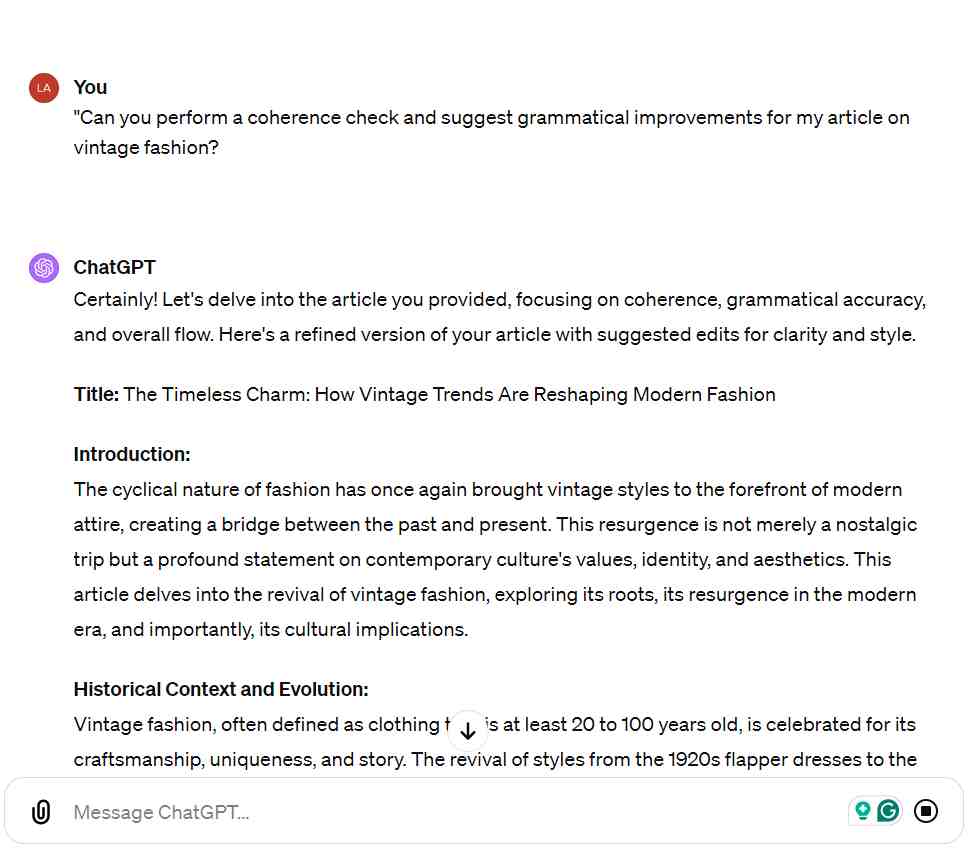In an era where technology and creativity intersect, AI tools are redefining the norms of fashion content creation.
Machine learning and natural language processing in artificial intelligence revolutionize the fashion industry by predicting trends through data analysis and personalizing customer experiences with tailored recommendations. This innovative approach is a cornerstone of how to write fashion articles with AI writing tools in India, leveraging AI to craft insightful and engaging content that captures the latest in fashion trends and consumer preferences.
However, writing a fashion article takes time and effort, and this is where the best AI writing tools in India can help. Here, I’m going to talk about how to write fashion articles using AI writing tools.
How to Write Fashion Articles with AI Writing Tools in India ?– A Step-by-Step Guide
Incorporating AI writing tools into fashion writing requires a careful blend of innovation and traditional storytelling, embodying the principle of how to write fashion articles with AI writing tools in India. Here are some recommendations:
Step 1: Select a Fashion-Related Topic
Choosing the right topic is the foundation of any great fashion article. This involves:
- Analyzing Current Fashion Trends: Utilize AI-powered data analysis tools to understand current fashion trends. These tools can sift through vast amounts of data from fashion shows, online retail sites, and fashion magazines to identify emerging patterns.
- Exploring Social Media: AI algorithms can scan social media platforms to pick up on what fashion topics are trending. This helps in understanding what the audience is talking about and interested in.
- Identifying Gaps in Existing Fashion Content: AI can help you spot areas that haven’t been extensively covered, offering opportunities to create unique and fresh content.
- Selecting Passion-Driven Topics: Choose topics that you are passionate about. This passion will translate into more engaging and authentic content.
Practical implication:
Considering the need to select a pertinent fashion topic, I asked ChatGPT, “What are the key fashion trends identified from the latest fashion shows and online retail sites?” The AI provided insights into emerging patterns like the resurgence of vintage styles and eco-friendly materials, which I chose as the focus for my next article to align with current market interests.

Step 2: Identify Your Fashion Audience
Understanding your audience is crucial for tailoring your content effectively:
- Demographic Analysis: Use AI to analyze the age, gender, and fashion preferences of your audience. This information can help tailor your content to suit their tastes and interests.
- Interests and Preferences: AI tools can segment audiences based on their interests in specific fashion genres, designers, or movements.
- Knowledge Level Tailoring: Adjust the complexity of your content to cater to either fashion novices or aficionados.
Practical implication:
Understanding the importance of audience targeting, I inquired with ChatGPT, “Can you analyze the fashion preferences of millennials from social media discussions?” Utilizing AI, I gained knowledge about millennials’ gravitation towards sustainable and ethically produced fashion, enabling me to tailor my content to their preferences, thus increasing reader engagement.

Step 3: Research the Fashion Topic
In-depth research adds credibility and depth to your article:
- Access to Specialized Sources: AI tools provide access to fashion-specific journals, trend reports, and designer interviews, giving you a wealth of information to draw from.
- Incorporating Expert Insights: Include insights and quotes from fashion influencers and industry experts, which AI tools can help identify and compile.
- Source Tracking for Accuracy: Maintain accuracy and avoid plagiarism by using AI tools to keep track of all your sources.
Practical implication:
Recognizing the need for in-depth research, I tasked ChatGPT with “Provide me with a synthesis of the latest designer interviews and fashion journals on sustainable materials in fashion.”

Step 4: Create an AI-Assisted Outline
Structuring your article is made simpler with AI:
- Heading Suggestions: Your chosen AI tool can suggest headings and subheadings based on popular fashion article formats and your content’s specific focus.
- Organizing Content: AI helps organize your thoughts and research findings into a coherent structure, offering flexibility for rearrangements or edits.
Practical implication:
To structure my article effectively, I requested ChatGPT to “Suggest an outline for an article on the impact of vintage trends making a comeback.” The AI proposed a detailed outline that helped me systematically present my research and analysis, facilitating a coherent and engaging narrative for readers.

Step 5: Write the Draft with AI Assistance
When drafting your article, remember the following:
- AI-Generated Initial Content: Use AI to create initial drafts based on your outline, focusing on each point and filling it out with relevant content.
- Maintain a Relevant Narrative: Ensure that your writing reflects the latest fashion trends and insights, keeping your content current and engaging.
- SEO Optimization: Integrate keywords naturally throughout your draft, utilizing AI tools for optimal placement and density.
Practical implication:
Aiming to produce a relevant draft, I asked ChatGPT, “Generate a draft focusing on vintage fashion’s resurgence and its cultural implications.”

Step 6: Edit and Proofread Using AI Tools
Finally, refine your article with the help of AI:
- Structural and Coherence Checks: AI tools can review your article’s structure and overall coherence, suggesting improvements where necessary.
- Grammar and Readability Enhancements: AI-powered grammar checkers can spot and correct errors, enhancing the readability of your content.
- Human Feedback for Nuance: Especially for subjective areas of fashion, seek human feedback to add a nuanced touch to your content.
Practical implication:
To refine my article, I sought ChatGPT’s assistance, asking, “Can you perform a coherence check and suggest grammatical improvements for my article on vintage fashion?” The AI’s suggestions polished my article, improving its readability and ensuring a professional presentation to my audience.

How to Effectively Integrate AI Writing Tools in Your Fashion Writing?
In the quest to master how to write fashion articles with AI writing tools in India, the integration of AI with traditional content writing is crucial.
This blend not only fuels innovation but also preserves the authenticity of storytelling in the fashion world. Here’s how you can effectively Integrate AI writing tools:
- Start with AI-driven research: Use AI tools to gather data on current trends, color schemes, and popular designers. This step ensures that your articles are relevant and up-to-date.
- Drafting with a Human Touch: Leverage AI for initial drafts, focusing on structure and SEO optimization. Then, infuse your unique voice and style, adding personal insights and experiences related to fashion.
- Finalizing with a Personal Flair: While AI can suggest edits for grammar and readability, the final touch should be human. This involves fine-tuning the narrative, ensuring it resonates with your audience’s fashion sensibilities.
Enhancing Fashion Narratives: The Role of AI in Crafting Engaging Content
In fashion journalism, understanding how AI writing tools help in creating fashion content is pivotal for crafting stories that captivate and resonate.
Here’s how AI tools are revolutionizing the way we create fashion content, focusing on personalization and heightened reader engagement:
Tailored Content Creation:
AI algorithms analyze reader preferences and behaviors, enabling the creation of highly customized content. This leads to articles that closely align with the interests and tastes of the target audience.
Dynamic Engagement Strategies:
By leveraging data-driven insights, AI tools help in identifying the topics and styles that generate the most reader engagement, ensuring that fashion articles are not only stylish but also strategically appealing.
Consistent Brand Voice with AI Assistance:
AI writing tools can adapt to maintain a consistent brand voice across all content. This consistency is crucial in fashion writing, as it helps to establish a recognizable and trusted voice in a competitive industry.
Building a Personal Connection: AI’s Role in Enhancing Fashion Storytelling
Let’s explore how AI is transforming the art of storytelling in fashion. AI tools have been instrumental in creating compelling fashion narratives.
For instance, an AI-driven analysis of consumer data enabled a fashion brand to weave a story around sustainable fashion, effectively connecting with environmentally conscious consumers.
This approach, blending data insights with creative AI, enhances storytelling, resulting in a powerful campaign that boosted brand loyalty.
Another example is the use of AI in personalized marketing campaigns. By analyzing customer preferences and behaviors, AI helped a luxury fashion house create personalized data and stories for each segment of its audience.
This tailored approach resulted in highly engaging content, making each reader feel uniquely understood and connected to the brand.
Promoting Inclusivity: AI’s Impact on Diversity in Fashion Writing
In the ever-evolving world of fashion, how AI writing tools foster diversity and inclusion in fashion writing is a question that opens the door to a more inclusive and representative industry.
You can even use a youtube script generator to generate promotional content for your brand.
By leveraging AI, fashion content can mirror the diverse fabric of society, making every individual feel seen and heard. Here’s how AI is making a difference:
- Diverse Perspective Analysis: AI tools can analyze global fashion trends, ensuring content is not limited to a single cultural perspective. This broader viewpoint helps create fashion narratives that are diverse and inclusive.
- Inclusive Language Algorithms: Specialized artificial intelligence programs assist in identifying and eliminating biases in language, promoting more inclusive and sensitive communication. This is vital in crafting fashion content that resonates with a wider audience, respecting cultural and individual differences.
In the quest to create more inclusive and diverse fashion content, several AI tools have emerged as key players. There’s more to AI tools than just ChatGPT,
Here’s a closer look at how other tools are contributing to diversity in the fashion writing industry:
Textio:
This tool is a game-changer when learning how to write fashion articles with AI writing tools in India as it promotes inclusive language in fashion content. This will make sure to use natural language processing to generate fashion content for your website . Textio analyzes your writing and provides real-time suggestions to make it more inclusive.

It’s particularly useful in ensuring that fashion articles and marketing materials appeal to a broad audience without unintentional bias.
By identifying phrases that could be potentially exclusive or offensive, Textio helps fashion brands communicate more effectively with diverse audiences.
Grammarly:
Known for its grammar-checking capabilities, Grammarly goes a step further in fostering inclusivity. It offers suggestions to avoid gendered language and stereotypes, which is crucial in fashion writing.
The fashion industry, with its wide and diverse audience, needs to ensure that the content is free from language that reinforces stereotypes or excludes certain groups.

Grammarly’s AI algorithms can detect subtle uses of biased language, helping writers create more gender-neutral and inclusive content.
Pymetrics:
Pymetrics stands out by using AI to ensure diverse and unbiased content creation. This tool leverages neuroscience and AI to provide insights into the way content might be perceived by different groups.
In fashion writing, where appealing to a global and diverse audience is key, Pymetrics can be used to tailor content that resonates across cultural and demographic lines.

It helps in identifying any unconscious biases in the content and suggests modifications to make it more inclusive and appealing to a wider audience.
Navigating Ethics: The Role of AI in Fashion Content Integrity
Now that you know how to write fashion articles with AI writing tools in India, it’s imperative to consider the ethical considerations when using AI writing tools:
Maintaining Creative Control:
It’s crucial to ensure that AI tools are used as assistants rather than replacements in the creative process. This involves using AI for tasks like data analysis and idea generation while keeping the final creative decisions in human hands.
Ensuring Authenticity:
AI-generated content must be carefully overseen to retain the authentic voice of the brand or writer. The unique perspective and personal touch that define fashion writing should not be lost in automated content.
Transparency in AI Usage:
Being transparent about the use of AI in content creation helps maintain trust with the audience. This involves disclosing the extent to which AI tools are used in the creative process.
Avoiding Bias in AI Algorithms:
Ensuring that AI tools do not perpetuate stereotypes or biases is crucial. Regular audits and updates of these tools can help in minimizing any unintended bias in content. make sure to avoid bias in AI advanced algorithms.
Protecting Intellectual Property:
As AI generates content based on existing materials, safeguarding intellectual property rights is a significant concern. Fashion brands and writers must ensure that AI-generated content does not infringe on others’ creative works.
Respecting Data Privacy:
When using AI tools that analyze consumer data for content personalization, it’s essential to adhere to data privacy laws and ethical standards.
These considerations highlight the importance of a balanced approach in leveraging AI for fashion writing. It’s about maximizing the efficiency of content and insights offered by AI while upholding the ethical standards that foster trust and authenticity in the fashion industry.
Why Are AI Writing Tools Revolutionary in Fashion Content Creation?
AI writing tools have introduced a new level of creativity in fashion content creation. By analyzing vast amounts of data, these tools can generate unique and trend-focused content ideas that might not be immediately apparent to human writers.
Moreover, AI tools embody the pinnacle of technological innovation in content creation. They streamline the writing process, from initial research to final edits, significantly reducing the time and effort required.
This efficiency does not come at the expense of quality; AI tools often enhance the readability and SEO effectiveness of content, ensuring it reaches and engages the intended audience more effectively.
Key Benefits of AI in Fashion Content Writing:
- Data-Driven Insights: AI tools analyze consumer trends and preferences, providing valuable insights for tailored content.
- Enhanced Creativity: They suggest innovative ideas and styles, injecting a fresh perspective into fashion writing.
- Efficiency in Content Production: AI accelerates the content creation process, from research to publication.
- Consistency in Brand Voice: AI can maintain a consistent brand voice across various content pieces.
- SEO Optimization: AI tools are adept at integrating keywords naturally, improving search engine rankings.
- Personalization: AI enables the creation of personalized content for different audience segments.
FAQs
How can AI be used in fashion?
How many fashion brands use AI?
Can I use ChatGPT for articles?
What is the AI tool to create articles?
Conclusion: Embracing the Future of Fashion Writing with AI
AI writing tools offer a unique blend of technological innovation and artistic expression, making them indispensable in the modern fashion writing arena.
As we look forward, the integration of AI in fashion writing is not just a trend but a paradigm shift. Writers, brands, and marketers in the fashion industry are encouraged to explore and embrace these AI tools.
Now that you know how to write fashion articles with AI writing tools in India, why stop there? There are a lot of things that AI can help with, from writing biographies to science fiction. To learn more, check out the articles in the how-to guides and AI glossary on allaboutai.com.





